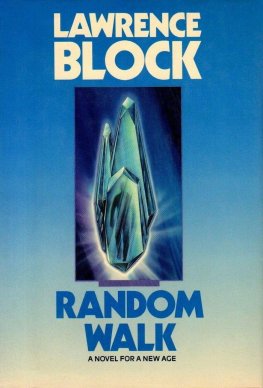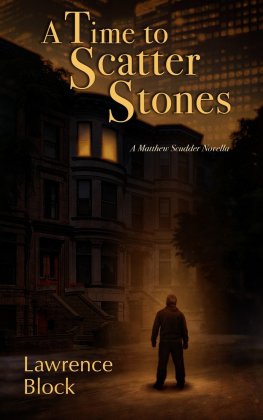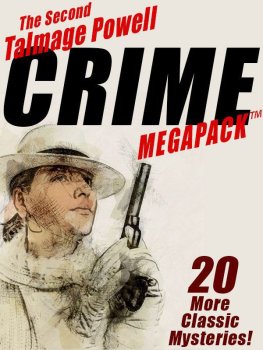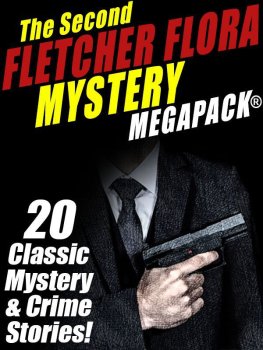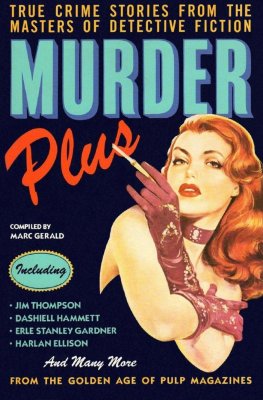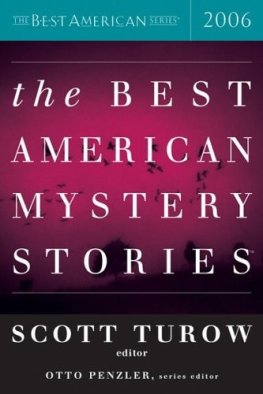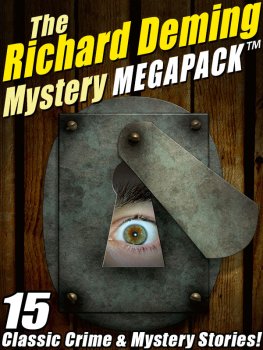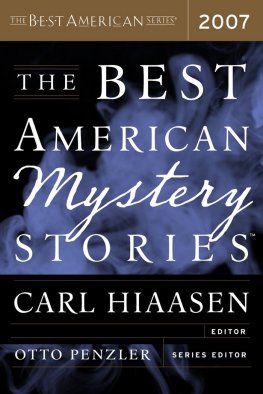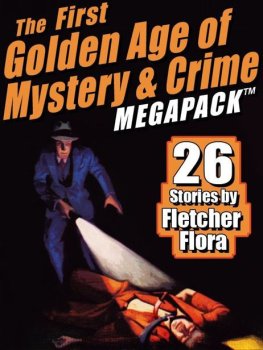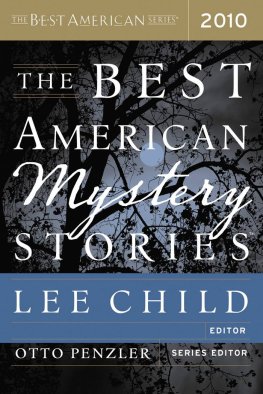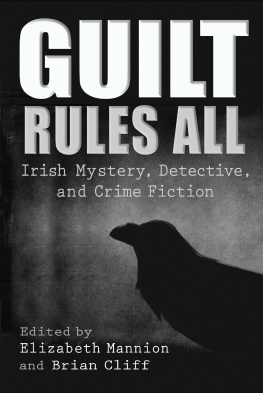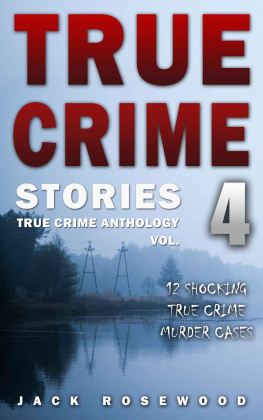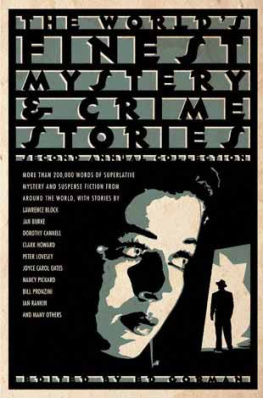The Best American Mystery Stories 2001
Things That Make Your Heart Beat Faster by Jennifer Anderson. First published in The Missouri Review. Copyright 2000 by Jennifer Anderson. Reprinted by permission of the author.
Lobster Night by Russell Banks. First published in Esquire. Copyright 2000 by Russell Banks. Reprinted from The Angel on the Roof by permission of HarperCollins Publishers, Inc.
Prison Food by Michael Downs. First published in Witness. Copyright 2000 by Michael G. Downs. Reprinted by permission of the author.
In the Zone by Leslie Edgerton. First published in High Plains Literary Review. Copyright 2000 by Leslie Edgerton. Reprinted by permission of the author.
The Paperhanger by William Gay. First published in Harpers Magazine. Copyright 2000 by William Gay. Reprinted by permission of the author.
A Book of Kells by Jeremiah Healy. First published in Mary Higgins Clark Mystery. Copyright 2000 by Jeremiah Healy. Reprinted by permission of the author.
Eries Last Day by Steve Hockensmith. First published in Alfred Hitchcocks Mystery Magazine. Copyright 2000 by Steve Hockensmith. Reprinted by permission of the author.
Under Suspicion by Clark Howard. First published in Ellery Queens Mystery Magazine. Copyright 2000 by Clark Howard. Reprinted by permission of the author.
Her Hollywood by Michael Hyde. First published in Alaska Quarterly Review. Copyright 2000 by Michael Hyde. Reprinted by permission of the author.
Family by Dan Leone. First published in Literal Latte. Copyright 2000 by Dan Leone. Reprinted by permission of the author.
Blood Sport by Thomas Lynch. First published in Witness. Copyright 2000 by Thomas Lynch. Reprinted by permission of the author.
Carnie by David Means. First published in Witness. Copyright 2000 by David Means. Reprinted by permission of Georges Borchardt, Inc.
Tides by Kent Nelson. First published in The Georgia Review. Copyright 2000 by Kent Nelson. Reprinted by permission of the author.
The Girl With the Blackened Eye by Joyce Carol Oates. First published in Witness. Copyright 2000 by The Ontario Review, Inc. Reprinted by permission of The Ontario Review, Inc.
Easy Street by T. Jefferson Parker. First published in Easy Street, by T. Jefferson Parker, ASAP Press. Copyright 2000 by T. Jefferson Parker. Reprinted by permission of the author.
The Big Bite by Bill Pronzini. First published in The Shamus Game, edited by Robert J. Randisi, Signet. Copyright 2000 by the Pronzini-Muller Family trust. Reprinted by permission of the author.
Missing in Action by Peter Robinson. First published in Ellery Queens Mystery Magazine. Copyright 2000 by Peter Robinson. Reprinted by permission of the author.
The Face-Lift by Roxana Robinson. First published in The Atlantic Monthly. Copyright 2000 by Roxana Robinson. Reprinted by permission of the author.
Big Ranch by John Salter. First published in Third Coast. Copyright 2000 by Nathan Walpow. Reprinted by permission of the author.
Push Comes to Shove by Nathan Walpow. First published in A Deadly Dozen: Tales of Murder from Los Angeles, edited by Susan B. Casmier, Aljean Harmetz, and Cynthia Lawrence, Uglytown. Copyright 2000 by Nathan Walpow. Reprinted by permission of the author.
This is the fifth volume in this series of Best American Mystery Stones from the distinguished publishing house Houghton Mifflin, and, I dont know, but it may well be the best yet.
There are quite a few authors here who were previously unknown to me, just as there are among those on the honor roll the other distinguished mystery stories of 2000. Many of the genres more familiar names are not present in this collection, either because they failed to write short stores this past year or because some of these new voices simply produced superior work. This is, for all of us who are serious readers, whether of mystery fiction or of any fiction at all, a very good thing. Its a comfort to know that the pipes remain full, and that the future of the story is secure.
Ive noticed one major change since I became the series editor five years ago: That first year, there were a handful of stories published as electronic originals. The next year there were a few more. This year I probably saw 250 to 300 of them, keeping the total number of stories examined well beyond a thousand.
To be frank, most of the electronically published stories are not terribly outstanding. Not much editing occurs on many sites in the e-publishing world, and often not much selectivity, either, so its not surprising that the vast bulk of those stories have nothing original or stylistically compelling about them. However, and this is significant, not a single story in the 1997 volume even made it to the honor roll. This year several did, and several others were pretty close. I can conclude only that more and more good material will show up on these sites among all the dross, and it wont be long before a story, or more than one, cracks the ice and makes it into the book.
Some things dont change much. More of the stories are crime or suspense stories stories of character and motivation than detective stories. This is probably because the pure detective story may be the hardest kind of short fiction to write. On the other hand, it may be that younger authors are more interested in delving into personality and psychology than in puzzles. Either way, this phenomenon gives the anthology a range that would be impossible if all the tales were of observation and detection.
The other thing that doesnt change much is that this years guest editor, Lawrence Block, has selected a story by Joyce Carol Oates, who breaks her own record by appearing in this annual for the fourth time. In case you missed it, she was also nominated for another National Book Award, her sixth, for the brilliant Blonde, a novel about Marilyn Monroe. Eighteen of the other authors all make their first appearance in Best American Mystery Stories, the exception being Peter Robinson, who brightens these pages for the second time.
Lawrence Block, who has had stories in two previous volumes, was named a Grand Master by the Mystery Writers of America for his lifelong achievements in the world of mystery fiction. He is a former president of that organization and a multiple winner of the Edgar Allan Poe Award in both the Best Novel and Best Short Story categories. As guest editor, he was ineligible to have a story selected for this volume. It would, after all, be a mite unseemly for him to select one of his own stories, however worthy.
Im sure you will agree that it was worth that sacrifice when you read his amusing introduction and revel in his selections. I wish he could have found room for one or two stories that I loved and he didnt, but there you are. Immediately after I got his list of stories for the book I called him to say that I had done my own rankings and, astonishingly, eighteen of my top twenty stories were on his list. I can only commend his superb taste.
No volume in this series should ever be published without my sincere expression of gratitude to Michele Slung, the fastest and smartest reader on the planet, without whom this book would require three years to compile. She examines literally thousands of stories to determine if they are mystery- or crime-related, and then makes a determination of whether they are good enough to be seriously considered. You will find several listings, both among selected stories and those on the honor roll, from what may be defined as arcane sources for this genre, and that is a tribute to her own detective skills in ferreting out worthwhile fiction for these pages.

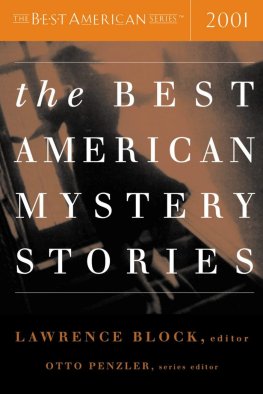
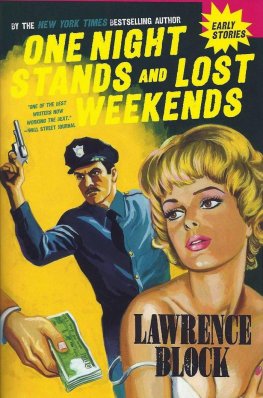
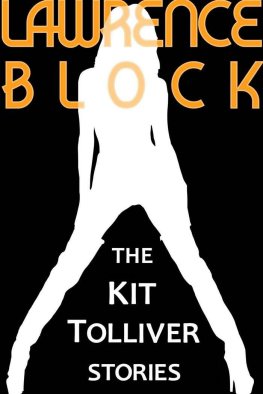
![Lourens Blok - Death Pulls a Doublecross [= Cowards Kiss]](/uploads/posts/book/873811/thumbs/lourens-blok-death-pulls-a-doublecross-cowards.jpg)
